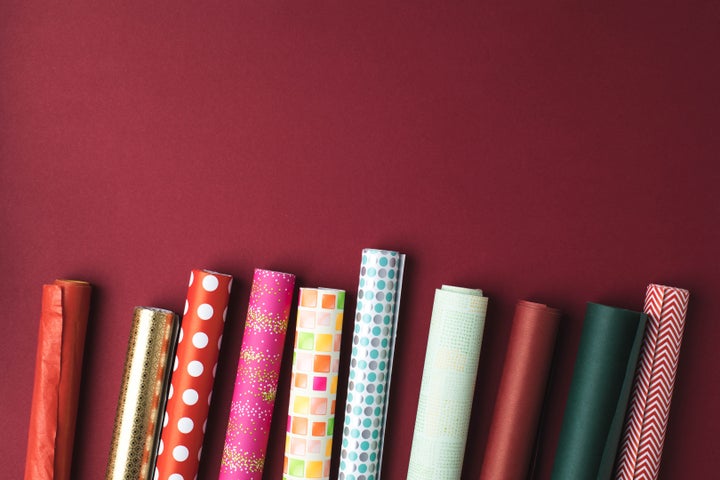
We’re still throwing away our money on wrapping paper.
According to an August report from Sundale Research, people in the U.S. spent a total of $12.7 billion on gift wrap, including wrapping paper, tissue paper and gift bags, in 2017. What a waste. This is stuff designed to be torn into shreds and tossed away in less than 60 seconds.
It’s time to do away with wrapping paper, once and for all, and here’s why: Most wrapping paper is not recycled (and much of it can’t be), so it ends up in landfills.
A lot of the paper you might think is recyclable is actually lined with plastic, according to Going Zero Waste’s Kathryn Kellogg.
Do you like decorations and artistic flourishes on your presents? Well, be selective. “If it has glitter or tape, it’s not recyclable,” Celia Ristow of Litterless told HuffPost.
Glitter-encrusted paper is especially terrible for a couple of reasons. It can’t be recycled, for one. What’s more, glitter is made from teensy pieces of plastic that not only appear in your hair weeks later but also pollute the oceans, according to National Geographic. Marine animals often ingest these little specks, and over time, collect them in their stomachs, which can be fatal.
Santa would never.

Even recyclable gift wrap will probably go to a landfill at the end of its life. Wrapping paper accounts for a tiny fraction of paper made from recycled material (while cardboard accounts for much more). Gift wrap is just not the ideal item to recycle: It’s thin and often full of ink, which makes it difficult to extract fibers from during recycling.
“The ink diminishes the yield, it creates extra sludge when you process it, it requires additional chemicals,” according to Bill Moore, a paper recycling consultant based in Atlanta.
Giving up wrapping paper shouldn’t really be so tough. “There are things that seem really hard for us as a culture to give up,” said Ristow. “Packaged foods, we can avoid them, but we’re humans and sometimes we need to grab something on the go.”
Wrapping paper, however “seems like it should be much easier to give up,” she argued. “To me, it’s a no-brainer to focus first on those things that are less dear and easier to replace.”
“You can get creative with your wrapping vessel. Tie up items in a tea towel or scarf, making the cloth a part of the present. Use old newspaper or magazine cutouts, and make wrapping an event.”
If you were all about doing away with single-use plastic straws, then it only makes sense for you to hop on the anti-wrapping paper bandwagon. It’d be both hypocritical and counterproductive not to.
Straws at least serve a unique purpose. Some people with disabilities need them for drinking liquids; and while there are plenty of non-plastic straw substitutes out there, the options haven’t been perfected. Paper straws and similar biodegradable options may be too flimsy for people with limited jaw mobility, for example, NPR reported.
No one’s life is substantially better-served with wrapping paper. OK, it looks cheery and festive. But there are plenty of cheaper alternatives.
“I still wrap most of my gifts in brown paper saved from packages,” said Ristow. “Despite our best efforts, we’re going to order stuff online and it’ll come with, at best, paper.”
Kellogg agreed that brown paper can be made into a beautiful wrapping option, especially when spruced up with a sprig of evergreen, a dehydrated orange slice of a stick of cinnamon (and then you have the added bonus of scented gift wrap). With this option, “you still get the feeling of getting to rip through paper,” Kellogg said, with the ability to recycle when you’re done.
Ristow also said that she’ll save ribbons that have been gifted to her household, and instead of transparent tape, she opts for washi tape, an adhesive option that’s made from natural fibers and can be recycled with brown paper.
Reusable packaging may even be part of your holiday tradition already. Consider the Christmas stocking, a gift-holding receptacle you take out year after year to store goodies.
You also likely reuse ornaments to decorate the tree. Why should holiday wrapping be any different?
Beyond reused paper, you can get creative with your wrapping vessel. Tie up items in a tea towel or scarf, making the cloth a part of the present. Use old newspaper or magazine cutouts, and make wrapping an event, said Kellogg: “If I had children, I think it would be a lot of fun as a family tradition to draw on paper.”
As Ristow pointed out, this doesn’t have to be an all-or-nothing option. “Part of the fun of wrapping is the chance to get creative, but that doesn’t always have to involve materials that’ll end up in the landfill,” she said. “We have a lot more opportunity to keep the joy without the environmental cost.”
May your holidays be shiny, bright and as eco-friendly as possible!
This story is part of a series on plastic waste, funded by SC Johnson. All content is editorially independent, with no influence or input from the company.
